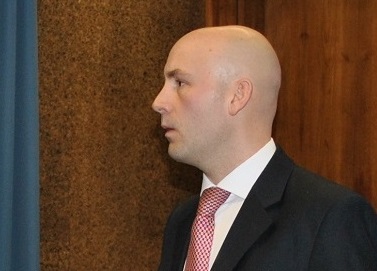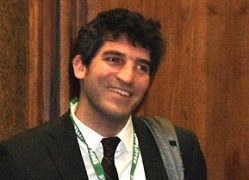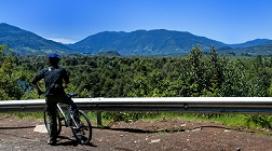MIT Humphrey Fellows Share Knowledge on Argentine Rail, Chilean Biking
Two Hubert H. Humphrey Fellows recently spoke about their research during talks at Volpe. Rodrigo Rodriguez Tornquist examined challenges for the Argentine railway system, while Cristian Navas considered how Chilean transportation planners can encourage bicycle use.
Each year, the Massachusetts Institute of Technology (MIT) Special Program for Urban and Regional Studies (SPURS) hosts several Humphrey Fellows; nine fellows were selected for the 2013-14 academic year. The Humphrey program, administered by the U.S. Department of State, sponsors 200 fellows at college campuses spanning a range of industrial and academic fields. The MIT SPURS program hosts Humphrey fellows who are mid-career professionals in international development.
In 2012, SPURS and Volpe began collaborating to bring the international perspective of these fellows to U.S. DOT. Since then, at least one fellow each year completes a six-week professional affiliation at Volpe, working within one of Volpe’s technical divisions.
Argentine Rail: Turning the Tide of Mismanagement
Modern passenger rail in Argentina began with the state-run Ferrocarriles Argentinos (FA) in 1948, explained Tornquist, an environmental specialist at the Argentine Secretariat of Transport, where he heads the Environmental Management Division at the National Railways Administration. The system ran smoothly for the first few decades. But, by the 1980s, labor disputes and political unrest led to corruption at FA, with yearly costs rising to 1 percent of Argentina’s GDP. High costs and unrest led to a system that did not provide safe, quality rail transport.
A private consortium of companies took over in 1994. Again, things started well. Corruption subsided, and trains were safe and ran on time. Then, in 2001, Argentina went bankrupt. Regulations and enforcement relaxed, creating fissures for corruption to again seep in.
 “When one of the oldest problems of humankind—lack of transparency—shows up in the transportation framework, you have a lot of problems, even with a private system,” Tornquist said.
“When one of the oldest problems of humankind—lack of transparency—shows up in the transportation framework, you have a lot of problems, even with a private system,” Tornquist said.
In the past few years, riders have borne the consequences.
In February 2012, a train carrying more than 1,500 passengers crashed into the Once Station in Buenos Aires, killing 52 and injuring 700, said Tornquist. The accident was caused by faulty brakes and malfunctioning hydraulic bumpers. A year and a half later, in October 2013, another train crashed at that same station, injuring more than 100 people. Four months earlier, a train on the same line crashed near Castelar station, killing 3 and injuring more than 300.
After the accidents in 2012 and 2013, Argentina again hit the reset button, turning to public management for passenger rail, with freight rail split between five private operators and a public operator. Tornquist is determined this time around to see the cycle of mismanagement and tragedy broken.
“We understand that railways are an important legacy,” Tornquist said. “The recovery of railroads is strategic, for passengers and freight, and for the competitiveness of our country. We need strong political will from society to make sure people understand that this is not about one administration but that it is a plan for the entire nation.”
Today, regulatory bodies like the one that Tornquist works for provide stability through better maintenance and management, cracking down on operators that do not follow protocol, offering high fare subsidies—as high as 85 percent—and carrying out what Tornquist calls a “shock of investment” to revamp Argentina’s rails.
Chilean Bicycling and the Perception of Poverty
Cities in Chile aren’t like New York, Boston, Portland, or San Francisco, where professionals ride their bikes to and from work and for pleasure, said Navas, a transportation planner who worked in the office of the Chilean Undersecretary of Transportation for five years. In Chile, cycling has a perception problem: if you ride a bike, you must be poor.
That perception began to soften around 2007, when the Sustainable Transport Unit, a division that Navas established within the office of the Chilean Undersecretary of Transportation, began a baseline study of how bikes were used across Chile.

The study found that 40 percent of daily trips were made by walking, while only 3 to 5 percent were made by bike.
Biking and walking were far less common in northern Chile. In southern Chile, bikes accounted for up to 13 percent of trips.
Why the regional divide? Navas explained that the difference is likely cultural, tied in with the climate, which is more favorable in the north. In the south, Chileans historically used horses more than in the north. One study participant told Navas that, in the south, they traded the horse for the bike.
The Chilean government has so far spent $400,000 to help reverse the bicycling stigma, including a Ride to School Program for elementary school kids.
“When the diagnostic started, there was a bad perception of the bike. If you rode a bike it was because you couldn’t afford a car,” Navas said. “Now we are seeing a change. Most people still think that way, but with sustainability issues being promoted, people are thinking of buying homes close to work and biking there.”
In Chile, increasing bike ridership is about promoting bike culture. And changing the culture around cycling starts at the top.
“In the case of Chile, it’s a very centralized government,” Navas said. “When the national government sets a policy, it is very strong and the local agencies follow that.”
Bringing the World to Volpe
No two countries are the same, and no solution for one country will necessarily work for another. But the lessons and perspectives brought here from around the globe are reason enough for transportation planners to pause and think. Which cities in the United States have a bike perception problem? Are there more opportunities for public-private partnerships in rail? These insights brought by the Humphrey/SPURS fellows help spur the ideas that keep Volpe humming with cutting-edge transportation research.

